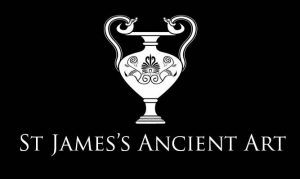Many items of ancient glassware were designed for tableware use, in particular for carrying and serving water and wine at banquets. Jugs, like this example, were one of the most frequently used containers, and existed in different dimensions and shapes.
The variety of shapes and sizes seen in ancient glassware was achieved through the technique of glassblowing, which by the 1st century AD had revolutionised the art of glassmaking. It allowed for easier manipulation of the glass, but also for a quicker paced production, as the hot glass would be blown into a mould and then removed whilst still hot so that the glass maker could still work on it. Different minerals were added to create a variety of colours; the yellow tint seen in this piece would have been created by adding lead and changing the oxygen levels. The iridescence on ancient Roman glass was unintentional, and was caused by weathering on its surface. The extent to which a glass object weathers depends mainly on the burial conditions; however, the humidity, heat, and type of soil in which the glass was buried also all affect its preservation.
To learn more about Roman glass, visit our relevant post: How It Was Made: Roman Glass











